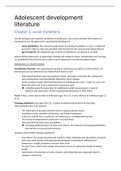Adolescent development
literature
Chapter 3: social transitions
Like the biological and cognitive transitions of adolescence, the social transitions have important
consequences for the adolescent’s psychosocial development.
- social redefinition: The process through which an individual’s position or status is redefined
by society. Likely to raise new questions and concerns for the young person about intimacy.
- age of majority: The designated age at which an individual is recognized as an adult.
experts define adolescence as beginning in biology and ending in culture. menstruation and marriage
are probably the best ones to use in order to see if adolescence actually has gotten longer.
Adolescence as a Social Invention
Inventionists Theorists: who argue that the period of adolescence is mainly a social invention. It is
only because we see adolescence as distinct that it exists as such
- With industrialization came new patterns of work, education, and family life. Adolescents
were among those most dramatically affected by these changes.
- society needed to begin discriminating between individuals who were “ready” for work and
those who were not. à term adolescence became to exist
a lengthy period of preparation for adulthood in which young people, in need of
guidance and supervision, remain economically dependent on their elders
Youth: Today, a term used to refer to individuals ages 18 to 22; it once referred to individuals ages 12
to 24.
Emerging adulthood: from ages 18 to 25, a unique developmental period in its own right,
characterized by five main features:
- The exploration of possible identities before making enduring choices
- Instability in work, romantic relationships, and living arrangements
- A focus on oneself and, in particular, on functioning as an independent person
- The feeling of being between adolescence and adulthood
- The sense that life holds many possibilities
emerging adulthood does not exist in all cultures. the existence of emerging adulthood is
not entirely an economic phenomenon.
Findings mental health emerging adulthood:
- Over 80% of the sample showed great stability in their well-being over the period, consistent
with many other studies indicating that psychological functioning in childhood and
adolescence is highly predictive of success later in life
- For more than a sixth of the sample, this period was one of substantial change in mental
health
- experiences in the domains of work, romance, and citizenship were especially linked to
changes in well-being.
,Changes in status during adolescence
The young person is often permitted more extensive participation in the community’s decision
making. à initiation ceremony: The formal induction of a young person into adulthood.
- Once an adolescent is designated as an adult, she or he is also subject to a new set of laws.
- Certain crimes are adjudicated in a separate juvenile justice system (We use the term status
offense to refer to a behavior that is problematic because of the young person’s status as a
juvenile) which operates under different rules and principles than the criminal justice system
that applies to adults.
Legal decisions tend to set the age boundary high when the behavior in question is viewed as
potentially damaging to the young person (e.g., buying alcohol) but low when the behavior is thought
to have potential benefit.
Social redefinition: the initiation ceremony usually marks the beginning of a long period of training
and preparation for adulthood, not the adolescent’s final passage into adult status.
In many cultures the young people of a community are grouped with peers of approximately the
same age—a cohort—and move through the series of status transitions together.
- Real or Symbolic Separation from Parents
- Emphasizing Differences Between the Sexes
- Passing on Information from the Older Generation
Variation in clarity
- The Clarity of Social Redefinition in Contemporary Society
- Adolescents’ Views of Themselves
- The Clarity of Social Redefinition in Traditional Cultures
- The Clarity of Social Redefinition in Previous Eras
Variations in Continuity
continuous transitions: Passages into adulthood in which adult roles and statuses are entered into
gradually. The opposite is discontinuous transition.
- The Continuity of the Adolescent Passage in Contemporary Society (we tend to exclude
young people from the world of adults)
- The Continuity of the Adolescent Passage in Traditional Cultures
- The Continuity of the Adolescent Passage in Previous Eras
- Current Trends in Home Leaving
, - Youngsters from some minority groups—Black, Latinx, and Native American youth, in
particular—have more trouble negotiating the transition into adulthood than do their White
and Asian counterparts.
- Poverty is associated with failure in school, unemployment, delinquency, depression, and
teen pregnancy, all of which contribute to transitional difficulties
Adolescents who lack positive adult role models are more likely to have psychological and behavioral
problems. à mentoring
The Influence of Neighborhood Conditions on Adolescent Development
Because poor families tend to live in poor neighborhoods, it is not always easy to separate the effects
of neighborhood disadvantage from the effects of family disadvantage. Although their living
circumstances improved, their subjective social status declined.
- The Price of Privilege: When teenagers begin experimenting with alcohol and illegal drugs,
which may be fueled by pressure to excel in school and extracurricular activities and enabled
by parents who are either too preoccupied to notice or simply choose to look the other way.
à more problems
, - Impact of Poverty on Adolescent Development: growing up in a poor neighborhood has
devastating effects on adolescent behavior, achievement, and mental health, and these
effects are above and beyond those attributable to growing up in a poor family or attending a
financially strapped school.
Processes of Neighborhood Influences
- Collective Efficacy: A community’s social capital, derived from its members’ common values
and goals
- The Impact of Stress: Across all ethnic groups, poverty is associated with harsh, inconsistent,
and punitive parenting, which, in turn, are linked to adolescent misbehavior
- Limited Access to Resources: adolescents who grow up in poor neighborhoods have more
limited access to resources than do those who grow up in more advantaged communities.
Chapter 13: Psychosocial Problems in Adolescence
Some General Principles About Problems in Adolescence
Most Problems Reflect Transitory Experimentation
There is a difference between occasional experimentation and enduring patterns of dangerous or
troublesome behavior. Not every risky behavior in adolescence leads to criminal behavior.
Not All Problems Begin in Adolescence
There is also a difference between problems that have their origins and onset during adolescence
and those that have their roots during earlier periods of development.






